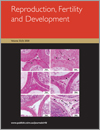Continued research is necessary to select individual spermatozoon from a given sample of stallion semen that will maximise blastocyst production using intracytoplasmic sperm injection. In this study, a lower cleavage rate was observed for equine spermatozoa cryopreserved in glycerol versus dimethyl sulfoxide. Increased blastocyst production and individual stallion variation was observed among the two cryoprotectant treatments studied, which warrants further critical examination among additional cryoprotectants in a larger sample of stallions.

Reproduction, Fertility and Development
Volume 32 Number 3 2020
The roles of vascular endothelial growth factor A (VEGFA) in ovaries are closely connected with its distribution and expression. This study investigated the uneven distribution and varied expression of VEGFA, which revealed multiple functions of VEGFA in theca and granulosa cells during follicular development and atresia process. Our results enriched the knowledge of VEGFA and provided references for livestock production and reproductive medicine.
Mitochondrial DNA has widely been reported to be associated with complex traits, but its effect on the litter size of pigs has not been widely analysed. Mitochondrial haplogroups of pigs differed significantly in litter size, which may be due to diverse maternal origins. Mitochondrial haplogroups could serve as a marker for genetic selection for pig litter size.
RD19134Potential physiological involvement of nesfatin-1 in regulating swine granulosa cell functions
Reproduction is conditioned by metabolic factors, only some of which are known. This study explored the role of the novel peptide nesfatin-1 in ovarian function. The peptide was localised in the swine ovary and its functions are described. The results of this study contribute to a better understanding of the intricate metabolic network that affects ovarian function.
RD18514Late-onset vanishing testis-like syndrome in a 38,XX/38,XY agonadic pig (Sus scrofa)
This study describes a rare case of agonadism in an SRY-positive pig presenting with ambiguous sexual traits and sex chromosome disorder of sex development (DSD; 38,XX/38,XY). This pig also lacked Wolffian and Müllerian structures and sex steroids were undetectable. The DAX1 gene duplication in the presence of a wild-type SRY gene may have caused this predominantly female phenotype. To the best of our knowledge, this is the first reported case of an XX/XY chimeric, ovotesticular DSD associated with agonadism in pigs.
RD18472The antioxidant curcumin postpones ovarian aging in young and middle-aged mice
Ovarian aging as the earliest-aging organ is characterised by reduction of ovarian follicle quantity and quality, which is associated with impairment of oocyte developmental competence. This study was designed to prevent ovarian reserve loss in female mice by natural aging using curcumin as a well known antioxidant. Our data offer new insights into antioxidant therapy for postponing oocyte aging.
Mucopolysaccharidosis type I (MPS I) is a genetic disease that impairs the physiological function of many tissues. We used a murine model of MPS I to examine the epididymis and spermatozoa of adult mice. Although morphological evidence of damage to the epididymis was present, the spermatozoa were morphologically normal and motile compared with wild-type mice, and MPS I male mice were capable of mating.
Quercetin could improve polycystic ovary syndrome (PCOS) by its phytoestrogenic effects, mimicking oestrogen’s function. Also, quercetin affects obesity and diabetes factors such as adiponectin, nesfatin-1 and adiponectin receptor, thus improving the symptoms of PCOS. Quercetin significantly decreased oestrogen levels and might help fertility problems in PCOS patients.
RD19060Defining the gonadotrophin requirement for the selection of a single dominant follicle in cattle
The development of the ovulatory follicle, with a good-quality egg, is critical for fertility. The results of this study demonstrate conclusively the key patterns of FSH and LH for the growth and selection of the ovulatory follicle in cattle. These results may have significant implications for the design of more appropriate protocols for induction of multiple ovulations in cattle and also humans.
The primary localisation of vitamin D receptor (VDR) in ovarian granulosa cells indicates possible roles of vitamin D in follicular development, but the mechanism remains unclear. We demonstrated a dose-dependent effect of Vit D3 on proliferation of goat luteinised granulosa cells (LGC) and that VDR expression in LGCs may be associated with follicular development by regulation of cell proliferation and apoptosis. These findings could enhance the understanding of the molecular roles of Vit D3 and VDR in ovarian follicular development.




